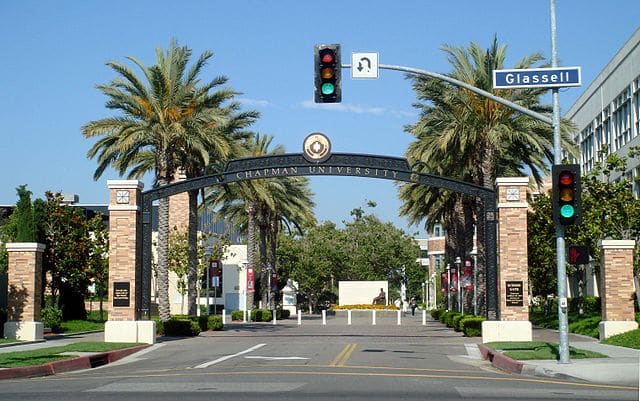Everybody knows: if you want to get into the movies, you’ve got to go to Hollywood. Well, more specifically, you need to go to Los Angeles. That’s where you’ll find actors, studios, agents – all the parts responsible for putting images up on the silver screen.
But more importantly, Los Angeles has a tremendous amount of film schools. Sure, anyone can make a movie using the phone they carry in their pocket. But the craft of filmmaking involves a lot more than just pointing a camera at something and yelling “action!” If you want to make a mark in Hollywood, you’ll need to understand directing, cinematography, and editing, to say nothing of the many network connections you’ll need to establish.
You can get all of those skills and resources at film school. In film school, you’ll work under experts in the field who have perfected their techniques. You’ll collaborate with other people passionate about the art, who will challenge you to create your best work. Furthermore, film school will give you access to technology that is standard in the industry, but far too expensive for most people to afford.
Schools in Los Angeles will give you all of those opportunities and put you in contact with industry professionals. But not all film schools are the same, and with so many choices available, it’s easy to get overwhelmed.
Here are 10 of the best film schools in Los Angeles.
Columbia College Hollywood
Building off the model of its Chicago-based predecessor, Columbia College Hollywood takes a student-centered approach to teaching the film arts.
Based in the Tarzana area, CC-H offers a perfect environment in which young filmmakers can learn their trade. Screenings, classes, and events are held in either the school’s 96-seat 5.1 channel surround sound theater or its smaller 35-seat 7.1 channel surround sound screening room. Students can create productions on the school’s sound stage or its three-camera HD television stage, which also features a green screen and a control room.
Those learning editing and other behind-the-scenes skills can take advantage of the Foley/ADR suite, which has a sound-isolated booth and a control room or any of its post-production editing suites. Finally, CCH also has plenty of standard sets, writers’ rooms, and traditional classrooms, as well as a 5,000-square-foot Learning Resource Center.
Biola University School of Cinema and Media Studies
Biola University School of Cinema and Media Studies enjoys acclaim from many of the top industry magazines, with Variety, The Wrap, and Filmmaker ranking the school among the best in the country.
In addition to a faculty comprised of industry professionals and a campus that features state-of-the-art equipment, Biola offers film studies from a Christian perspective. Students learn how to use filmmaking as an expression of faith. That’s particularly attractive to those who see their interest in media as a calling.
With these resources at their disposal, Biola has trained graduates who go on to work for major studios such as Lucasfilm and Universal pictures, contributing to culture-defining projects including The Avengers and New Girl. These connections will put Biola students on the path toward making a tangible impact on the industry.
Occidental College

At Occidental College, the Media Arts & Culture department combines the practical concerns of production with a background in media theory, through which students develop critical and creative skills for creating increasingly participatory media. Taking advantage of its position in downtown Los Angeles, the only liberal arts school with that distinction, OC Media Arts places students in the heart of the movie-making business.
But while the school is a proud member of the Los Angeles community, it does not allow its students to remain stuck in the area. OC’s Media Arts program strongly encourages students to participate in study abroad opportunities, which enable them to learn the craft of filmmaking in England, the Czech Republic, New Zealand, and elsewhere. In these locales, students will gain new skills and gain a perspective of filmmaking as an increasingly global trade.
California State University, Northridge

In a fast-changing field like film and entertainment, up-to-date technology is a must. That’s why the Department of Cinema and Television Arts at California State University – Northridge put its $80,000 grant from the Hollywood Foreign Press Association to good use. Over the course of three years, the school has updated its production facilities with new cameras and sound and lighting equipment.
This new equipment augments CTVA’s already impressive resources. The department features film and television sound stages, post-production and mixing suites, a new media lab, and a digital visual effects and animation suite. Events and shows are broadcast in the 130-seat Elaine and Alan Armer Screening Room, and the CSUN Cinematheque programs film series and other events.
With such a strong program, it’s no wonder that CTVA can boast of alumni such as Ami Cohen, who recently became Vice President of Physical Production-Television at Lionsgate Entertainment.
Loyola Marymount University School of Film and Television

The School of Film and Television at Loyola Marymount University prides itself not only on its small class sizes (12:1 student to faculty ratio) but also its equitable student body, 49% of which is female.
This commitment to diversity is not just an advertising number, but a key part of the school’s teaching. In March of 2021, Associate Professor Miranda Banks moderated a roundtable on “Anti-Racist Film and Media Pedagogy,” in association with EDIT Media. The talk helped students think critically about the media they create and engage with, which gave direction to their future projects.
It’s projects such as these that help LMU-SFTV gain attention from observers. On the most recent lists, the school ranked 7th in the nation, according to both The Hollywood Reporter and Animation Career Review.
American Film Institute Conservatory
At the American Film Institute’s Conservatory, those who come to study are not just “students;” they are “fellows.” More than a mere quirk of nomenclature, the term fellows reflects the school’s approach to film study, which treats every member as a participant in a larger project. The fellows learn from one another, each improving the quality of the community as they hone their craft.
Over their two years in the program, fellows must work on several short films, with minimum oversight from faculty. In the creation of these projects, fellows experience a type of boot camp that introduces them to the essentials of filmmaking, including cinematography, directing, editing, and more.
As challenging as the program sounds, no one can argue with the results. Former AFI fellows include masters of the form such as Terrance Mallick, David Lynch, and Julie Dash.
California Institute of the Arts School of Film/Video

Founded in 1961, the California Institute of the Arts School of Film/Video has long been recognized as one of the world’s best film schools, especially for those studying animation. Not only did Walt Disney himself pick animators from Cal Arts forerunner Chouinard Art Institute, but the school trained many titans of the industry, including Brad Bird, Henry Selick, and John Musker.
Building on the work of these impressive graduates, Cal Arts works to advance the arts by emphasizing openness, experimentation, critical engagement, and creative freedom. “Through artistic practice,” declares the school’s motto, “we transform ourselves, each other, and the world.”
The school continues its history of excellence with initiatives such as the Herb Alpert Award in Arts, an unrestricted prize of $75,000 given every year to “risk-taking mid-career artists working in the fields of dance, film/video, music, theatre, and the visual arts.” Past winners have included filmmakers Craig Baldwin and Sharon Lockart.
Chapman University Dodge College of Film and Media Arts

Part of Chapman University in Orange, CA, the Dodge College of Film and Media Arts serves approximately 1,465 students, including 256 in the graduate program.
The school offers several points of interest for future filmmakers. At the 76,000 sq. ft. Marion Knott Studios, students have access to a working production studio, which includes two sounds stages, cinematography and directing insert stage, a television and broadcast journalism high-definition stage and control room, a foley stage, and more. Students can practice using state-of-the-art equipment, such as a Spirit 4K Datacine.
The 18,000 sq. ft. Digital Media Arts Center is a working, industry-standard studio, which combines “hang-out spaces” with classrooms and laboratories. These labs include a 32-workstation dual-monitor digital arts computer lab with 22″ HD Cintiq drawing surface and ergotron extension arm, a 25-workstation digital arts computer lab with 22” HD Cintiq drawing surface and ergotron extension arm with 2d animation light-box drawing station, ten private digital arts suites, large-format scanners, and 2d animation down-shooters for traditional hand-drawn animation.
University of Southern California School of Cinematic Arts

Founded in 1929, the University of Southern California School of Cinematic Arts is the oldest film school in the country and one of the most respected. CNTV offers not only programs in film production screenwriting, and other common issues, but also the Peter Stark Producing program and the Business of Entertainment programs. These classes teach students the critical art of selling and marketing films and television shows.
With such a unique program, it comes as no surprise that CNTV is highly selective, offering admission to only 2% of the applicants it receives. But those who do make it into the program get to learn their trade in the shadow of some of the greatest names in Hollywood. In CNTV’s School of Cinematic Arts Complex, students stage productions on the 20th Century Fox Soundstage, screen 3D presentations in the George Lucas and Steven Spielberg Buildings, and learn advanced special effects in the Robert Zemeckis Center for Digital Arts.
UCLA School of Theater, Film and Television

As indicated by its placement on the top of this list, the UCLA School of Theater, Film, and Television is one of the best film schools in the world. UCLA TFT regularly falls in the top five of national rankings, including those from U.S. News & World Report and The Hollywood Reporter.
In addition to a faculty consisting of some of the best in the business, including, UCLA TFT features resources such as the Geffen Playhouse, home to award-winning productions of American Buffalo and Miss Julie. The school also houses the unique UCLA Film & Television Archive, the world’s most extensive university-based collection, with over 220,000 motion picture and television titles and 27 million feet of newsreel footage. In keeping with its student-centered focus, UCLA TFT offers admission to only 4% of its applicants, allowing for a faculty-to-student ratio of 1:5.














